Sloane Taylor's Blog, page 95
May 10, 2016
Sorry for the inconvenience, but my blog is down for cons...
Sorry for the inconvenience, but my blog is down for construction. New posts will resume May 9.
Have a great weekend!
Sloane
Have a great weekend!
Sloane
Published on May 10, 2016 22:30
May 8, 2016
DEFINING THE NOVELLA
by Carol Browne
As authors go, I consider myself to be fairly ignorant when it comes to the mechanics of my craft. I’m like someone who drives but hasn’t a clue how the engine works and can’t tell one make of car from another. I find myself perplexed at times by the multitude of genres and their crossovers. Similarly, the many structures and formats one is supposed to adhere to are tiresome. Perhaps I don’t like rules and regulations, or it could be I’m too lazy to learn them.
Recently, when I finished my latest work, a novella called Reality Check, I decided to address my ignorance of basic literary structures by finding out exactly what constitutes a novella.
 The novella (Italian,‘new’) started to develop as a literary genre during the Renaissance (notably in 1348 with the The Decameron by Giovanni Boccaccio), and in the late-eighteenth and early-nineteenth centuries the genre acquired various rules and structural requirements.
The novella (Italian,‘new’) started to develop as a literary genre during the Renaissance (notably in 1348 with the The Decameron by Giovanni Boccaccio), and in the late-eighteenth and early-nineteenth centuries the genre acquired various rules and structural requirements.
With a word count of between 17,500 and 40,000, the novella tends to be more complex than a short story but has far fewer conflicts than a novel. Frequently a novella is designed to be read at a single sitting.
Chapter divisions, subplots, different points of view, and changes in genre are not features commonly found in the novella. It turns its back on the wider world to focus instead on personal development. It’s like taking a short story then embellishing it with descriptive passages, expanding on the characterisation, and exploring the conflicts in greater depth.
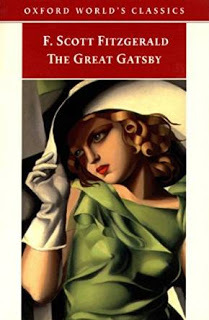 You’d be surprised to know how many great literary works are novellas—Franz Kafka’s The Metamorphosis, John Steinbeck’s Of Mice and Men, F. Scott Fitzgerald’s The Great Gatsby, and Oscar Wilde’s The Picture of Dorian Grey, to name but a few.
You’d be surprised to know how many great literary works are novellas—Franz Kafka’s The Metamorphosis, John Steinbeck’s Of Mice and Men, F. Scott Fitzgerald’s The Great Gatsby, and Oscar Wilde’s The Picture of Dorian Grey, to name but a few.
I’m surprised to find that Reality Check meets the requirements, albeit by accident! Out of interest I also note that German writers see the novella as a narrative of any length that focuses on one suspenseful situation or conflict, with a decisive turning point that leads to a reasonable but surprising conclusion. Reality Check has ticked all the boxes there too. All I need now is a publisher!

Carol Browne regards Crewe, Cheshire, as her home town and graduated from Nottingham University in 1976 with an honors degree in English Language and Literature. Carol writes speculative fiction, non-fiction, and poetry. She is also a ghost blog writer, proofreader, copy editor, and copywriter. Along with a passion for gardening, Carol is an avid animal lover.
Carol lives in the Cambridgeshire countryside with her dog, Harry, and cockatiel, Sparky.Pagan and vegan, Carol believes it is time for a paradigm shift in our attitude to Mother Nature and hopes the days of speciesism are numbered.
Stay connected with Carol on her website and blog , Facebook , and Twitter .
As authors go, I consider myself to be fairly ignorant when it comes to the mechanics of my craft. I’m like someone who drives but hasn’t a clue how the engine works and can’t tell one make of car from another. I find myself perplexed at times by the multitude of genres and their crossovers. Similarly, the many structures and formats one is supposed to adhere to are tiresome. Perhaps I don’t like rules and regulations, or it could be I’m too lazy to learn them.
Recently, when I finished my latest work, a novella called Reality Check, I decided to address my ignorance of basic literary structures by finding out exactly what constitutes a novella.
 The novella (Italian,‘new’) started to develop as a literary genre during the Renaissance (notably in 1348 with the The Decameron by Giovanni Boccaccio), and in the late-eighteenth and early-nineteenth centuries the genre acquired various rules and structural requirements.
The novella (Italian,‘new’) started to develop as a literary genre during the Renaissance (notably in 1348 with the The Decameron by Giovanni Boccaccio), and in the late-eighteenth and early-nineteenth centuries the genre acquired various rules and structural requirements.With a word count of between 17,500 and 40,000, the novella tends to be more complex than a short story but has far fewer conflicts than a novel. Frequently a novella is designed to be read at a single sitting.
Chapter divisions, subplots, different points of view, and changes in genre are not features commonly found in the novella. It turns its back on the wider world to focus instead on personal development. It’s like taking a short story then embellishing it with descriptive passages, expanding on the characterisation, and exploring the conflicts in greater depth.
 You’d be surprised to know how many great literary works are novellas—Franz Kafka’s The Metamorphosis, John Steinbeck’s Of Mice and Men, F. Scott Fitzgerald’s The Great Gatsby, and Oscar Wilde’s The Picture of Dorian Grey, to name but a few.
You’d be surprised to know how many great literary works are novellas—Franz Kafka’s The Metamorphosis, John Steinbeck’s Of Mice and Men, F. Scott Fitzgerald’s The Great Gatsby, and Oscar Wilde’s The Picture of Dorian Grey, to name but a few.I’m surprised to find that Reality Check meets the requirements, albeit by accident! Out of interest I also note that German writers see the novella as a narrative of any length that focuses on one suspenseful situation or conflict, with a decisive turning point that leads to a reasonable but surprising conclusion. Reality Check has ticked all the boxes there too. All I need now is a publisher!

Carol Browne regards Crewe, Cheshire, as her home town and graduated from Nottingham University in 1976 with an honors degree in English Language and Literature. Carol writes speculative fiction, non-fiction, and poetry. She is also a ghost blog writer, proofreader, copy editor, and copywriter. Along with a passion for gardening, Carol is an avid animal lover.
Carol lives in the Cambridgeshire countryside with her dog, Harry, and cockatiel, Sparky.Pagan and vegan, Carol believes it is time for a paradigm shift in our attitude to Mother Nature and hopes the days of speciesism are numbered.
Stay connected with Carol on her website and blog , Facebook , and Twitter .
Published on May 08, 2016 22:30
May 3, 2016
Something Smells Good!
Alicia Joseph is here with a delicious pasta bake that is not only easy to prepare, but freezes great and reheats perfectly.
Rotelle pasta resembles little wheels with spikes. If you don't have rotelle, as I didn't when I wanted to cook this recipe, try campanelle which is another curved pasta and it worked great for me.
The kitchen is all yours, Alicia!
Rotelle Ricotta Bake
 1 (16oz) pkg. rotelle (corkscrew) pasta
1 (16oz) pkg. rotelle (corkscrew) pasta
1 (8oz) pkg. sliced part-skim mozzarella cheese
1 (10 oz) pkg. frozen chopped spinach, thawed
3 eggs
1 (15 1/2 oz) carton part-skim ricotta cheese
1 (14 oz) jar marinara sauce
⅔ cup grated Parmesan cheese or Romano cheese
1 tsp. salt to taste
½ tsp. ground black pepper
½ tsp. basil, optional
½ tsp. garlic powder, optional
Heat oven to 375°F.
Cook rotelle according to package directions. Drain.
Butter a 13 X 9 inch baking pan.
Cut mozzarella into ¾ inch strips.
Lay spinach in a colander and press out as much liquid as possible.
Lightly beat eggs in a large bowl, stir in ricotta cheese, marinara sauce, Parmesan or Romano cheese, salt, black pepper, spinach, rotelle and half of the mozzarella.
Spoon into prepared pan. Cover with foil.
Bake until hot, about 15 minutes.
Remove foil.
Arrange reserved mozzarella strips diagonally in rows over rotelle about 1½ inches apart.
Bake until cheese melts, 5 - 10 minutes more.
Mangiare Bene!
While dinner is baking, how about a teaser from one of Alicia's novellas?
Madison Andrews has spent her entire life ~unsuccessfully~ searching for love. She begins having vivid dreams of the same woman every night, and soon, Madison believes this woman is the love she has been searching for. Madison's dreams become more intense and she realizes the dreams she's having recreate moments taken from actual events from her life ~~ and this woman is there for all of it. Madison searches for her, but how can she find a woman she knows everything about... and yet nothing? She doesn't even know her name.
To read more of HER NAME, please click onto Amazon .
 Alicia Joseph grew up in Westchester, Illinois. Her first novella, Her Name, was published by Musa Publishing in 2014. Her Name is a sweet, romantic story about a woman who believes the beautiful woman she dreams about is the real love of her life.
Alicia Joseph grew up in Westchester, Illinois. Her first novella, Her Name, was published by Musa Publishing in 2014. Her Name is a sweet, romantic story about a woman who believes the beautiful woman she dreams about is the real love of her life.
Loving Again is her second published novella. Alicia is currently working on a new novel called A Penny on the Tracks, a coming of age story about love and friendship. Alicia has many works-in-progress that she hopes to finish soon.
When she is not writing, the author enjoys volunteering with animals, rooting for her favorite sports teams, and playing “awesome aunt” to her nine nieces and nephews.
Learn more about Alicia Joseph on her blog . Stay connected on Facebook and Twitter .
Rotelle pasta resembles little wheels with spikes. If you don't have rotelle, as I didn't when I wanted to cook this recipe, try campanelle which is another curved pasta and it worked great for me.
The kitchen is all yours, Alicia!
Rotelle Ricotta Bake
 1 (16oz) pkg. rotelle (corkscrew) pasta
1 (16oz) pkg. rotelle (corkscrew) pasta1 (8oz) pkg. sliced part-skim mozzarella cheese
1 (10 oz) pkg. frozen chopped spinach, thawed
3 eggs
1 (15 1/2 oz) carton part-skim ricotta cheese
1 (14 oz) jar marinara sauce
⅔ cup grated Parmesan cheese or Romano cheese
1 tsp. salt to taste
½ tsp. ground black pepper
½ tsp. basil, optional
½ tsp. garlic powder, optional
Heat oven to 375°F.
Cook rotelle according to package directions. Drain.
Butter a 13 X 9 inch baking pan.
Cut mozzarella into ¾ inch strips.
Lay spinach in a colander and press out as much liquid as possible.
Lightly beat eggs in a large bowl, stir in ricotta cheese, marinara sauce, Parmesan or Romano cheese, salt, black pepper, spinach, rotelle and half of the mozzarella.
Spoon into prepared pan. Cover with foil.
Bake until hot, about 15 minutes.
Remove foil.
Arrange reserved mozzarella strips diagonally in rows over rotelle about 1½ inches apart.
Bake until cheese melts, 5 - 10 minutes more.
Mangiare Bene!
While dinner is baking, how about a teaser from one of Alicia's novellas?
Madison Andrews has spent her entire life ~unsuccessfully~ searching for love. She begins having vivid dreams of the same woman every night, and soon, Madison believes this woman is the love she has been searching for. Madison's dreams become more intense and she realizes the dreams she's having recreate moments taken from actual events from her life ~~ and this woman is there for all of it. Madison searches for her, but how can she find a woman she knows everything about... and yet nothing? She doesn't even know her name.
To read more of HER NAME, please click onto Amazon .
 Alicia Joseph grew up in Westchester, Illinois. Her first novella, Her Name, was published by Musa Publishing in 2014. Her Name is a sweet, romantic story about a woman who believes the beautiful woman she dreams about is the real love of her life.
Alicia Joseph grew up in Westchester, Illinois. Her first novella, Her Name, was published by Musa Publishing in 2014. Her Name is a sweet, romantic story about a woman who believes the beautiful woman she dreams about is the real love of her life. Loving Again is her second published novella. Alicia is currently working on a new novel called A Penny on the Tracks, a coming of age story about love and friendship. Alicia has many works-in-progress that she hopes to finish soon.
When she is not writing, the author enjoys volunteering with animals, rooting for her favorite sports teams, and playing “awesome aunt” to her nine nieces and nephews.
Learn more about Alicia Joseph on her blog . Stay connected on Facebook and Twitter .
Published on May 03, 2016 22:30
May 1, 2016
Sailing the High Seas
My guest today is Susan Lodge, noted Regency romance author. Susan appears to have guest with her. Who do you have here, Susan?
I have brought along Hetty Avebury who is the heroine of Only a Hero Will Do. She wishes to share some advice about travelling at sea in the nineteenth century. Hetty unfortunately found herself trapped on a naval ship, uninvited and...
Excuse me, Susan. If I am not mistaken, you did say I could do this blog - after all I am the person who experienced the stressful, but enlightening, voyage and I don't want you to say anything indelicate. Perhaps you can go and arrange the refreshments. I will look after the visitors. Oh! Where are my guests precisely?
Okay, Hetty, you carry on. Trust me, they are out there listening, just talk – you’re good at that. But don’t give away too much of the plot before I come back.
Good! She has gone. Good day - are you there? Well I shall continue even though I fear my author has become quite addle brained. Did you know, dear guests, Susan’s ambition is to travel into space. Ha! What a strange thought. A coach that takes flight into the sky- without horses!
I hope she brings back some scones as I have a weakness for scones. In fact I have a few weaknesses. Gambling is one – luckily I am very good at it. My scheming family do not realize that I am able to gain funds this way. Therefore you might say it is also a strength.
Another weakness is books. I do love books! I can never get enough of the exciting informative kind (if you understand my meaning). The attendant at the library back home always examined my choices, so they were limited to the mundane. However, whilst I was at sea, Dr Withington lent me some books which were very informative.
But I must return our attentions to the purpose of this blog, where I will share some useful tips about sea travel.
So here are eight things a Regency lady needs to know about travelling (uninvited) on a naval ship in hostile waters.

1. Make sure you know which is the leeward side (the sheltered side) of the ship. It is important to know which way the wind is blowing when you are prone to seasickness. It was a shame about Doctor Withington’s coat-but luckily it was only his second best.
2. Do not stray from the quarterdeck. The stern end is the civilized end of the ship. Although it is a lot more colourful down the pointed end.
3. Prepare for your sleep to be interrupted. The ringing of the ship’s bell and the beating of drums occur at regular and unsociable times.
4. Do not complain of boredom, believe me that is a good sign. If you see a French ship approaching things will get very unpleasant, and you will soon wish to be bored again.
5. If you have a chance to pack for the journey (which I did not) include warm clothing. Also a supply of lemon juice is useful to bathe freckles, which multiply like a plague of insects across your skin once exposed to the sea air.
6. Prepare to be stoic. You will witness the misery and sacrifice of war. Even If you are lucky enough to avoid battle, deaths on board from injury and disease occur frequently.
7. Do remember to knock the weevils from the ships biscuits, and do not try to cut biscuits into delicate pieces; they resist all attempts.
8. If there is a tall, sombre physician around, whose job it is to keep you out of trouble, and looks at you with eyes … Oh, no – she is coming back with the tea - but alas no scones.
There is much more to tell, and if you feel like indulging in a romantic adventure and discovering what happened during and after my unscheduled voyage, please take a look at Only a Hero Will Do. (I haven’t even begun to tell you about Doctor Withington and you need to know about him.)
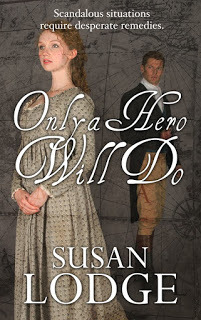 Marriage to a cruel dandy is not how Hetty Avebury envisions spending the rest of her life. Determined to avoid the match, she raises funds the only way she knows how – gambling. Her plans go astray and she finds herself on board a man-of-war under the care of its high handed physician. But Hetty soon realizes that Doctor Withington is not quite the stuffed shirt she had first imagined.
Marriage to a cruel dandy is not how Hetty Avebury envisions spending the rest of her life. Determined to avoid the match, she raises funds the only way she knows how – gambling. Her plans go astray and she finds herself on board a man-of-war under the care of its high handed physician. But Hetty soon realizes that Doctor Withington is not quite the stuffed shirt she had first imagined.
If it wasn’t bad enough declaring one of the pressed men as a woman, Robert has been tasked with the tiresome job of returning her safely back to her dysfunctional family. It was ten years ago when his father gambled away his inheritance, home, and any chance of marrying the woman he loved. So when Robert discovers Hetty gambling he takes drastic action to cure her of the habit.
Amazon Buy Link
 Susan Lodge’s first publication was a story for a UK national woman’s magazine. Heady with this breakthrough, she went on to write her first novel. She loves writing contemporary and historical romance, usually with a large dose of humour. Susan believes the romance genre lends itself superbly to funny moments, as love can make people act very oddly.
Susan Lodge’s first publication was a story for a UK national woman’s magazine. Heady with this breakthrough, she went on to write her first novel. She loves writing contemporary and historical romance, usually with a large dose of humour. Susan believes the romance genre lends itself superbly to funny moments, as love can make people act very oddly.
Susan has a science degree and always wanted to be an astronaut, but instead spent most of her career in the Civil Service. She would love to secure a seat on Richard Branson’s space flight. However, to find the funds she needs to either write a best seller or win the lottery.
After working in several cities including London and Bristol, she and her husband moved down to the Hampshire coast to raise their family.
Catch up with Susan on her website and blog . Stay connected on Facebook and Twitter .
I have brought along Hetty Avebury who is the heroine of Only a Hero Will Do. She wishes to share some advice about travelling at sea in the nineteenth century. Hetty unfortunately found herself trapped on a naval ship, uninvited and...
Excuse me, Susan. If I am not mistaken, you did say I could do this blog - after all I am the person who experienced the stressful, but enlightening, voyage and I don't want you to say anything indelicate. Perhaps you can go and arrange the refreshments. I will look after the visitors. Oh! Where are my guests precisely?
Okay, Hetty, you carry on. Trust me, they are out there listening, just talk – you’re good at that. But don’t give away too much of the plot before I come back.
Good! She has gone. Good day - are you there? Well I shall continue even though I fear my author has become quite addle brained. Did you know, dear guests, Susan’s ambition is to travel into space. Ha! What a strange thought. A coach that takes flight into the sky- without horses!
I hope she brings back some scones as I have a weakness for scones. In fact I have a few weaknesses. Gambling is one – luckily I am very good at it. My scheming family do not realize that I am able to gain funds this way. Therefore you might say it is also a strength.
Another weakness is books. I do love books! I can never get enough of the exciting informative kind (if you understand my meaning). The attendant at the library back home always examined my choices, so they were limited to the mundane. However, whilst I was at sea, Dr Withington lent me some books which were very informative.
But I must return our attentions to the purpose of this blog, where I will share some useful tips about sea travel.
So here are eight things a Regency lady needs to know about travelling (uninvited) on a naval ship in hostile waters.

1. Make sure you know which is the leeward side (the sheltered side) of the ship. It is important to know which way the wind is blowing when you are prone to seasickness. It was a shame about Doctor Withington’s coat-but luckily it was only his second best.
2. Do not stray from the quarterdeck. The stern end is the civilized end of the ship. Although it is a lot more colourful down the pointed end.
3. Prepare for your sleep to be interrupted. The ringing of the ship’s bell and the beating of drums occur at regular and unsociable times.
4. Do not complain of boredom, believe me that is a good sign. If you see a French ship approaching things will get very unpleasant, and you will soon wish to be bored again.
5. If you have a chance to pack for the journey (which I did not) include warm clothing. Also a supply of lemon juice is useful to bathe freckles, which multiply like a plague of insects across your skin once exposed to the sea air.
6. Prepare to be stoic. You will witness the misery and sacrifice of war. Even If you are lucky enough to avoid battle, deaths on board from injury and disease occur frequently.
7. Do remember to knock the weevils from the ships biscuits, and do not try to cut biscuits into delicate pieces; they resist all attempts.
8. If there is a tall, sombre physician around, whose job it is to keep you out of trouble, and looks at you with eyes … Oh, no – she is coming back with the tea - but alas no scones.
There is much more to tell, and if you feel like indulging in a romantic adventure and discovering what happened during and after my unscheduled voyage, please take a look at Only a Hero Will Do. (I haven’t even begun to tell you about Doctor Withington and you need to know about him.)
 Marriage to a cruel dandy is not how Hetty Avebury envisions spending the rest of her life. Determined to avoid the match, she raises funds the only way she knows how – gambling. Her plans go astray and she finds herself on board a man-of-war under the care of its high handed physician. But Hetty soon realizes that Doctor Withington is not quite the stuffed shirt she had first imagined.
Marriage to a cruel dandy is not how Hetty Avebury envisions spending the rest of her life. Determined to avoid the match, she raises funds the only way she knows how – gambling. Her plans go astray and she finds herself on board a man-of-war under the care of its high handed physician. But Hetty soon realizes that Doctor Withington is not quite the stuffed shirt she had first imagined.If it wasn’t bad enough declaring one of the pressed men as a woman, Robert has been tasked with the tiresome job of returning her safely back to her dysfunctional family. It was ten years ago when his father gambled away his inheritance, home, and any chance of marrying the woman he loved. So when Robert discovers Hetty gambling he takes drastic action to cure her of the habit.
Amazon Buy Link
 Susan Lodge’s first publication was a story for a UK national woman’s magazine. Heady with this breakthrough, she went on to write her first novel. She loves writing contemporary and historical romance, usually with a large dose of humour. Susan believes the romance genre lends itself superbly to funny moments, as love can make people act very oddly.
Susan Lodge’s first publication was a story for a UK national woman’s magazine. Heady with this breakthrough, she went on to write her first novel. She loves writing contemporary and historical romance, usually with a large dose of humour. Susan believes the romance genre lends itself superbly to funny moments, as love can make people act very oddly. Susan has a science degree and always wanted to be an astronaut, but instead spent most of her career in the Civil Service. She would love to secure a seat on Richard Branson’s space flight. However, to find the funds she needs to either write a best seller or win the lottery.
After working in several cities including London and Bristol, she and her husband moved down to the Hampshire coast to raise their family.
Catch up with Susan on her website and blog . Stay connected on Facebook and Twitter .
Published on May 01, 2016 22:30
April 26, 2016
Taming Your Beefaholic
Beef is a favorite with Studs and most men. Beef on bones is like mana from heaven to them. Must be something carried over from caveman days. Here's an easy recipe that will satisfy the beefaholic in your life.
Braised Beef Short Ribs
 2-3 pounds beef short ribs cut into 2-inch pieces
2-3 pounds beef short ribs cut into 2-inch pieces
Freshly ground pepper to taste¼ tsp. thyme
½ cup flour
2 tbsp. lard or solid shortening
2 medium onions, chopped
½ cup carrot, chopped
1 tbsp. garlic, pressed
¼ tsp. dried thyme
1 cup beef stock
2 small bay leaves
1 tbsp. Worcestershire sauce
Preheat oven to 325°F.
Pat ribs dry. Grind pepper over the meat. Pour flour into a paper bag. Add 2 - 4 ribs at a time. Shake bag gently to coat the meat. Remove the ribs and set on a large plate. Continue until all the ribs are coated.
Melt the lard or shortening in a Dutch oven over medium-high heat until it shimmers. Carefully add ribs and brown them on all sides. Don’t crowd the pan. You’re better off to brown the meat in batches. Return ribs to the plate. Lower heat to medium.
Add onions and carrots to the same pot. Sauté until onions are soft and transparent. Add garlic. Cook for 45 - 60 seconds.
Stir in the stock. Bring to a boil over high heat. Scrape in any brown bits clinging to the bottom and sides of the pan.
Reduce heat to medium. Stir in the remaining ingredients.
Nestle ribs in the pan and bring to a boil. Cover and then place in the oven. Braise the ribs for 1 ½ hours or until the meat shows no resistance when pierced with a fork.
Arrange ribs on a clean platter and tent with foil to keep them warm.
Strain the braising liquid through a fine sieve into a saucepan. Press down hard on the vegetables to extract the juices. Discard vegetable. Skim off the surface fat.
Bring the pan to a hard boil. Cook for 2-3 minutes to intensify the flavor.
Pour the sauce into a gravy boat and serve alongside the ribs.
Have a great weekend!
Sloane
Braised Beef Short Ribs
 2-3 pounds beef short ribs cut into 2-inch pieces
2-3 pounds beef short ribs cut into 2-inch piecesFreshly ground pepper to taste¼ tsp. thyme
½ cup flour
2 tbsp. lard or solid shortening
2 medium onions, chopped
½ cup carrot, chopped
1 tbsp. garlic, pressed
¼ tsp. dried thyme
1 cup beef stock
2 small bay leaves
1 tbsp. Worcestershire sauce
Preheat oven to 325°F.
Pat ribs dry. Grind pepper over the meat. Pour flour into a paper bag. Add 2 - 4 ribs at a time. Shake bag gently to coat the meat. Remove the ribs and set on a large plate. Continue until all the ribs are coated.
Melt the lard or shortening in a Dutch oven over medium-high heat until it shimmers. Carefully add ribs and brown them on all sides. Don’t crowd the pan. You’re better off to brown the meat in batches. Return ribs to the plate. Lower heat to medium.
Add onions and carrots to the same pot. Sauté until onions are soft and transparent. Add garlic. Cook for 45 - 60 seconds.
Stir in the stock. Bring to a boil over high heat. Scrape in any brown bits clinging to the bottom and sides of the pan.
Reduce heat to medium. Stir in the remaining ingredients.
Nestle ribs in the pan and bring to a boil. Cover and then place in the oven. Braise the ribs for 1 ½ hours or until the meat shows no resistance when pierced with a fork.
Arrange ribs on a clean platter and tent with foil to keep them warm.
Strain the braising liquid through a fine sieve into a saucepan. Press down hard on the vegetables to extract the juices. Discard vegetable. Skim off the surface fat.
Bring the pan to a hard boil. Cook for 2-3 minutes to intensify the flavor.
Pour the sauce into a gravy boat and serve alongside the ribs.
Have a great weekend!
Sloane
Published on April 26, 2016 22:30
April 24, 2016
Those Pesky Regency Facts
by Vonnie Hughes
Well, here we are at it again. Everyone involved in writing Regencies at some stage or other comes up against the argument - what is genuine Regency behaviour and wording, and what is not?
On the loops we complain about 21st century attitudes and words creeping in to our Regency books. There are two sides to this story.
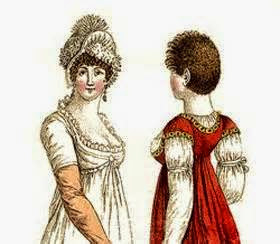 I'm all in favour of genuine. I cringe when a so-called Regency miss gets 'feisty' and wants to go out in the dead of night to teach some young buck a lesson. If she was of good birth, she'd be too closely guarded to get the chance to go fluttering around on her own at night. If she was careful of her reputation she simply wouldn't go out asking for trouble - it wouldn't occur to her. But there are ways around scenarios like this. They just have to sound 'period.' And there must be a VERY good reason for her to flout convention. Not just a yearning for excitement.
I'm all in favour of genuine. I cringe when a so-called Regency miss gets 'feisty' and wants to go out in the dead of night to teach some young buck a lesson. If she was of good birth, she'd be too closely guarded to get the chance to go fluttering around on her own at night. If she was careful of her reputation she simply wouldn't go out asking for trouble - it wouldn't occur to her. But there are ways around scenarios like this. They just have to sound 'period.' And there must be a VERY good reason for her to flout convention. Not just a yearning for excitement.
I don't go a bundle on the covers of books where shirtless guys bearing marked resemblance to gypsies (the old tall, dark and handsome I guess) leer down the genetically enhanced nippled decolletage of simpering young women in the throes of passion. At least I think it's passion. Some of 'em look constipated.
But I am all for writing books that are exciting for 21st century readers to enjoy. That's what it's about. A writer is an entertainer.
So a Regency author has to tread a fine line between what you can get away with (or what your editor lets you get away with) and still have that authentic flavour of the early 19th century. You can't disappoint your readers. And you mustn't have them chucking your book at the wall and saying, 'This is not Regency.' Do them the compliment of understand that many Regency readers are VERY knowledgeable about the period. They know the difference between a landau and a lorgnette. Or buckskins and a bufflehead.
I think any writer has to treat his/her audience with respect. As for Regency, it's a crowded Regency world out there at the moment and you don't want your reader defecting to a more authentic writer.
How to zap up the excitement? Don't look at me. I'm a dull, prissy writer. But I'd suggest a hero, heroine and villain out of the ordinary, or a setting that's really unusual like somewhere on the hero's Grand Tour or the cold Yorkshire moors. No more Almack's. And best, of all, I'd suggest a mystery or a crime with a villain that's not quite a villain. You know, a man who under other circumstances could easily be a friend, but he took a wrong turning. You can wring a lot of angst out of someone who is almost likeable.
The picture above is a genuine Regency miss c. 1806. She's an interesting young lady. You get the impression there are lots of secrets behind the eyes. Most all, I like a heroine with guts. Nobody wants to read a book with no conflict or danger or excitement. And I think the young lady in the sketch has a great story behind her.
~Vonnie
Here is a little from Vonnie's latest Regency.
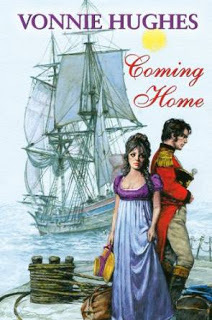 In the aftermath of a vicious rape, Juliana Colebrook shuns all men apart from the injured soldiers she nurses. Orphaned and alone, she desperately wants to leave Portugal for the protection of her relatives in England. However, there is still one man who invokes her admiration: Brigade-Major Colwyn Hetherington, with his self-deprecating sense of humour and innate sense of duty.
In the aftermath of a vicious rape, Juliana Colebrook shuns all men apart from the injured soldiers she nurses. Orphaned and alone, she desperately wants to leave Portugal for the protection of her relatives in England. However, there is still one man who invokes her admiration: Brigade-Major Colwyn Hetherington, with his self-deprecating sense of humour and innate sense of duty.
So when Colwyn is offered a dream job managing a large estate in Wiltshire, Juliana asks him to escort her back to England. But Colwyn has troubles of his own and when he is forced to reveal the nature of his woes to a stunned Juliana, everything changes. Mired in danger, who can Juliana trust? And what of Colwyn’s warning that families bring only trouble?
When Brigade-Major Colly Hetherington meets Miss Juliana Colebrook, he gives her a black eye. After the Battle of the Douro on the Iberian Peninsula he is severely wounded and only semi-conscious, but he is still coherent enough to know that he is behaving just as his father had predicted when he threw Colly out of the family home five years previously. Colly cannot be trusted around women.
Miss Colebrook, however, sees in Colly a wealth of kindness and a willingness to assume responsibility. She observes that he cares about the soldiers serving under him. If only…
Buy Links Amazon - Waterstones
 Vonnie Hughes is a multi-published author in both Regency books and contemporary suspense. She loves the intricacies of the social rules of the Regency period and the far-ranging consequences of the Napoleonic Code. And with suspense she has free rein to explore forensic matters and the strong convolutions of the human mind. Like many writers, some days she hates the whole process, but somehow she just cannot let it go.
Vonnie Hughes is a multi-published author in both Regency books and contemporary suspense. She loves the intricacies of the social rules of the Regency period and the far-ranging consequences of the Napoleonic Code. And with suspense she has free rein to explore forensic matters and the strong convolutions of the human mind. Like many writers, some days she hates the whole process, but somehow she just cannot let it go.
Vonnie was born in New Zealand, but she and her husband now live happily in Australia. If you visit Hamilton Gardens in New Zealand be sure to stroll through the Japanese Garden. These is a bronze plaque engraved with a haiku describing the peacefulness of that environment. The poem was written by Vonnie.
Learn more about Vonnie Hughes on her website and blog . Stay connected on Facebook and Goodreads .
Well, here we are at it again. Everyone involved in writing Regencies at some stage or other comes up against the argument - what is genuine Regency behaviour and wording, and what is not?
On the loops we complain about 21st century attitudes and words creeping in to our Regency books. There are two sides to this story.
 I'm all in favour of genuine. I cringe when a so-called Regency miss gets 'feisty' and wants to go out in the dead of night to teach some young buck a lesson. If she was of good birth, she'd be too closely guarded to get the chance to go fluttering around on her own at night. If she was careful of her reputation she simply wouldn't go out asking for trouble - it wouldn't occur to her. But there are ways around scenarios like this. They just have to sound 'period.' And there must be a VERY good reason for her to flout convention. Not just a yearning for excitement.
I'm all in favour of genuine. I cringe when a so-called Regency miss gets 'feisty' and wants to go out in the dead of night to teach some young buck a lesson. If she was of good birth, she'd be too closely guarded to get the chance to go fluttering around on her own at night. If she was careful of her reputation she simply wouldn't go out asking for trouble - it wouldn't occur to her. But there are ways around scenarios like this. They just have to sound 'period.' And there must be a VERY good reason for her to flout convention. Not just a yearning for excitement.I don't go a bundle on the covers of books where shirtless guys bearing marked resemblance to gypsies (the old tall, dark and handsome I guess) leer down the genetically enhanced nippled decolletage of simpering young women in the throes of passion. At least I think it's passion. Some of 'em look constipated.
But I am all for writing books that are exciting for 21st century readers to enjoy. That's what it's about. A writer is an entertainer.
So a Regency author has to tread a fine line between what you can get away with (or what your editor lets you get away with) and still have that authentic flavour of the early 19th century. You can't disappoint your readers. And you mustn't have them chucking your book at the wall and saying, 'This is not Regency.' Do them the compliment of understand that many Regency readers are VERY knowledgeable about the period. They know the difference between a landau and a lorgnette. Or buckskins and a bufflehead.
I think any writer has to treat his/her audience with respect. As for Regency, it's a crowded Regency world out there at the moment and you don't want your reader defecting to a more authentic writer.
How to zap up the excitement? Don't look at me. I'm a dull, prissy writer. But I'd suggest a hero, heroine and villain out of the ordinary, or a setting that's really unusual like somewhere on the hero's Grand Tour or the cold Yorkshire moors. No more Almack's. And best, of all, I'd suggest a mystery or a crime with a villain that's not quite a villain. You know, a man who under other circumstances could easily be a friend, but he took a wrong turning. You can wring a lot of angst out of someone who is almost likeable.
The picture above is a genuine Regency miss c. 1806. She's an interesting young lady. You get the impression there are lots of secrets behind the eyes. Most all, I like a heroine with guts. Nobody wants to read a book with no conflict or danger or excitement. And I think the young lady in the sketch has a great story behind her.
~Vonnie
Here is a little from Vonnie's latest Regency.
 In the aftermath of a vicious rape, Juliana Colebrook shuns all men apart from the injured soldiers she nurses. Orphaned and alone, she desperately wants to leave Portugal for the protection of her relatives in England. However, there is still one man who invokes her admiration: Brigade-Major Colwyn Hetherington, with his self-deprecating sense of humour and innate sense of duty.
In the aftermath of a vicious rape, Juliana Colebrook shuns all men apart from the injured soldiers she nurses. Orphaned and alone, she desperately wants to leave Portugal for the protection of her relatives in England. However, there is still one man who invokes her admiration: Brigade-Major Colwyn Hetherington, with his self-deprecating sense of humour and innate sense of duty. So when Colwyn is offered a dream job managing a large estate in Wiltshire, Juliana asks him to escort her back to England. But Colwyn has troubles of his own and when he is forced to reveal the nature of his woes to a stunned Juliana, everything changes. Mired in danger, who can Juliana trust? And what of Colwyn’s warning that families bring only trouble?
When Brigade-Major Colly Hetherington meets Miss Juliana Colebrook, he gives her a black eye. After the Battle of the Douro on the Iberian Peninsula he is severely wounded and only semi-conscious, but he is still coherent enough to know that he is behaving just as his father had predicted when he threw Colly out of the family home five years previously. Colly cannot be trusted around women.
Miss Colebrook, however, sees in Colly a wealth of kindness and a willingness to assume responsibility. She observes that he cares about the soldiers serving under him. If only…
Buy Links Amazon - Waterstones
 Vonnie Hughes is a multi-published author in both Regency books and contemporary suspense. She loves the intricacies of the social rules of the Regency period and the far-ranging consequences of the Napoleonic Code. And with suspense she has free rein to explore forensic matters and the strong convolutions of the human mind. Like many writers, some days she hates the whole process, but somehow she just cannot let it go.
Vonnie Hughes is a multi-published author in both Regency books and contemporary suspense. She loves the intricacies of the social rules of the Regency period and the far-ranging consequences of the Napoleonic Code. And with suspense she has free rein to explore forensic matters and the strong convolutions of the human mind. Like many writers, some days she hates the whole process, but somehow she just cannot let it go.Vonnie was born in New Zealand, but she and her husband now live happily in Australia. If you visit Hamilton Gardens in New Zealand be sure to stroll through the Japanese Garden. These is a bronze plaque engraved with a haiku describing the peacefulness of that environment. The poem was written by Vonnie.
Learn more about Vonnie Hughes on her website and blog . Stay connected on Facebook and Goodreads .
Published on April 24, 2016 22:30
April 19, 2016
Sunday Dinner Almost Like Mom Made
Once in a great while I'm compelled to cook a Sunday afternoon sit-down dinner like the one mom used to make. These aren't her recipes, but they are close. I hope you enjoy them as much as we do.
Braised Pork Loin
Mashed Potatoes
Homemade Applesauce
Steamed Asparagus
Crisp White Wine
Braised Pork Loin
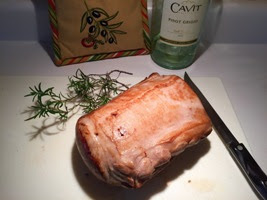 3 – 4 lb. boneless pork loin
3 – 4 lb. boneless pork loin
3 tbsp. lard or solid shortening
2 med. onions, peeled and sliced
1 lg. shallot, peeled and sliced
2 med. carrots, scraped and chopped
1 cup dry white wine
½ cup chicken stock
¾ tsp. dried thyme
½ tsp. marjoram
½ tsp. paprika
Freshly ground pepper to taste
Preheat oven to 350°F.
Pat the roast dry with paper towels. Melt lard in a Dutch oven over medium-high heat. Add pork and brown on all sides, about 20 minutes. Adjust the heat so as not to burn any part of the roast.
Set the meat on a plate. Reduce heat to medium. Sauté onions until they are soft and translucent, about 5 minutes. Stir in garlic and cook for 1 minute.
Add remaining ingredients to the pot and bring to a boil. Return the roast to the pot along with any accumulated juices on the plate. Cover tightly and braise in the center of the oven for 1½ hours or until a sharp knife inserts easily.
Set the roast on a cutting board and tent with foil. Skim fat from the braising liquid. Strain the liquid and vegetables through a sieve, pressing down hard with the back of a spoon to extract as much juice as possible before discarding the pulp.
Slice the pork into serving pieces and lay them on a platter. Moisten meat with a little of the sauce. Pour the remainder in a gravy boat and serve on the side.
Mashed Potatoes
 1 small russet potato per person
1 small russet potato per person
Chicken stock
Butter
Sour cream
Milk
Pepper
Parsley, snipped or chopped for garnish
Pour one inch chicken stock into saucepan. Peel and quarter the potatoes, then place in saucepan. Add tap water to cover by one inch. Put a lid on the pan and bring to a boil over medium heat. Lower temperature to a strong simmer. Cook approximately 20 - 25 minutes. They are done when a fork inserts easily into a potato.
Drain potatoes. Stir in butter, sour cream, and pepper. Mash well. Drizzle in the milk. Mash and continue to add milk until you achieve the consistency you prefer.
Homemade Applesauce
 6 lg apples cored, peeled, and coarsely sliced*
6 lg apples cored, peeled, and coarsely sliced*
1 cup sugar
4 tbsp. water
2 tbsp. lemon juice
1½ tbsp. soft butter
Combine all ingredients except butter in a saucepan. Bring to a boil over medium heat. Reduce heat, cover pot, and simmer 15 – 20 minutes or until apples mash easily with a fork.
Stir in the butter.
Mash with a potato masher. For a smoother texture pour the sauce into a blender or food processor and puree for a minute or so.
Turn into a serving bowl, cover, and refrigerate until ready to serve. This recipe also freezes well.
*Mix it up with a variety of apples to improve the flavor. Use six different types
Steamed Asparagus
 Photo by SOMMAI1 bunch asparagus
Photo by SOMMAI1 bunch asparagus
½ cup chicken stock
¼ cup dry vermouth or white wine
Water
2 tbsp. butter
Metal vegetable steamer
Add chicken stock and dry vermouth or wine to a medium size saucepan. Insert vegetable steamer, then add water to just below the bottom holes.
Snap off the ends of the asparagus and trim the spears to fit your saucepan. Add spears and cover. Bring to a boil over medium heat, adjusting the heat to a strong simmer. In 4-5 minutes the asparagus should be crisp tender.
Lay asparagus in a serving bowl. Spread the butter over them and serve.
I'm already looking for leftovers!
Sloane
Braised Pork Loin
Mashed Potatoes
Homemade Applesauce
Steamed Asparagus
Crisp White Wine
Braised Pork Loin
 3 – 4 lb. boneless pork loin
3 – 4 lb. boneless pork loin3 tbsp. lard or solid shortening
2 med. onions, peeled and sliced
1 lg. shallot, peeled and sliced
2 med. carrots, scraped and chopped
1 cup dry white wine
½ cup chicken stock
¾ tsp. dried thyme
½ tsp. marjoram
½ tsp. paprika
Freshly ground pepper to taste
Preheat oven to 350°F.
Pat the roast dry with paper towels. Melt lard in a Dutch oven over medium-high heat. Add pork and brown on all sides, about 20 minutes. Adjust the heat so as not to burn any part of the roast.
Set the meat on a plate. Reduce heat to medium. Sauté onions until they are soft and translucent, about 5 minutes. Stir in garlic and cook for 1 minute.
Add remaining ingredients to the pot and bring to a boil. Return the roast to the pot along with any accumulated juices on the plate. Cover tightly and braise in the center of the oven for 1½ hours or until a sharp knife inserts easily.
Set the roast on a cutting board and tent with foil. Skim fat from the braising liquid. Strain the liquid and vegetables through a sieve, pressing down hard with the back of a spoon to extract as much juice as possible before discarding the pulp.
Slice the pork into serving pieces and lay them on a platter. Moisten meat with a little of the sauce. Pour the remainder in a gravy boat and serve on the side.
Mashed Potatoes
 1 small russet potato per person
1 small russet potato per personChicken stock
Butter
Sour cream
Milk
Pepper
Parsley, snipped or chopped for garnish
Pour one inch chicken stock into saucepan. Peel and quarter the potatoes, then place in saucepan. Add tap water to cover by one inch. Put a lid on the pan and bring to a boil over medium heat. Lower temperature to a strong simmer. Cook approximately 20 - 25 minutes. They are done when a fork inserts easily into a potato.
Drain potatoes. Stir in butter, sour cream, and pepper. Mash well. Drizzle in the milk. Mash and continue to add milk until you achieve the consistency you prefer.
Homemade Applesauce
 6 lg apples cored, peeled, and coarsely sliced*
6 lg apples cored, peeled, and coarsely sliced*1 cup sugar
4 tbsp. water
2 tbsp. lemon juice
1½ tbsp. soft butter
Combine all ingredients except butter in a saucepan. Bring to a boil over medium heat. Reduce heat, cover pot, and simmer 15 – 20 minutes or until apples mash easily with a fork.
Stir in the butter.
Mash with a potato masher. For a smoother texture pour the sauce into a blender or food processor and puree for a minute or so.
Turn into a serving bowl, cover, and refrigerate until ready to serve. This recipe also freezes well.
*Mix it up with a variety of apples to improve the flavor. Use six different types
Steamed Asparagus
 Photo by SOMMAI1 bunch asparagus
Photo by SOMMAI1 bunch asparagus½ cup chicken stock
¼ cup dry vermouth or white wine
Water
2 tbsp. butter
Metal vegetable steamer
Add chicken stock and dry vermouth or wine to a medium size saucepan. Insert vegetable steamer, then add water to just below the bottom holes.
Snap off the ends of the asparagus and trim the spears to fit your saucepan. Add spears and cover. Bring to a boil over medium heat, adjusting the heat to a strong simmer. In 4-5 minutes the asparagus should be crisp tender.
Lay asparagus in a serving bowl. Spread the butter over them and serve.
I'm already looking for leftovers!
Sloane
Published on April 19, 2016 22:30
April 17, 2016
Time Travel 101…
by Sharon Ledwith
Legends. We love them. We can’t get enough of them. In fact we NEED them. Legends connect humanity in ways we can’t fathom. A legend, by definition is a story handed down for generations among a people and popularly believed to have a historical basis, although not verifiable. In book one of my time travel series, The Last Timekeepers and the Arch of Atlantis, Amanda Sault, her four classmates, and two tag-along adults are whisked through an arch they find buried in an overgrown garden, and transported to the mythical continent of Atlantis. They’ve been summoned to become Timekeepers—legendary time travelers sworn to keep history safe from an evil force known only as Belial. Oh, BTW—they’re not just any Timekeepers—they’re the Last Timekeepers. No pressure, right? Well, maybe a smidgen.
The Timekeepers first mission involves going back to 1214 England, actually Nottingham to be precise. There, Amanda and her time traveling cohorts meet an adolescent Robin Hood, although he is known as Robyn Hodekin to the people of Nottingham. So here’s the rub—in The Last Timekeepers and the Arch of Atlantis, what’s myth and what’s made-up? That’s when it’s up to the reader to seek the truth and dispel the lies.
Here’s a little help:

Robin Hood—if he did exist—was known by many names. Robyn Hode, Robert Earl of Huntingdon, Robert Fitz Ooth, and Robert fitz Odo to name a few. The first written references to our hero are brief. The earliest comes in the poem Piers Plowman, written in 1377 by the London cleric William Langland. One of his characters, an idle priest, says in passing, “I know the rhymes of Robin Hood,” but that is all. The oldest surviving substantial account of Robin Hood in his wider setting was printed in 1510, and is called A Geste of Robin Hood, the word Geste probably meaning a tale of heroic exploits. BTW—“Robin Hood in Sherwood stood” was one verse found preserved in a scrap of manuscript from Lincoln Cathedral, and was dated around 1410.
Mortimer’s Hole—The Mortimer and his hole in my story is fictional. The real Mortimer’s Hole is a 98 metre long man-made tunnel that takes you from the foot of castle rock up to the Upper Bailey in the castle grounds. It is named after Roger Mortimer. On the night of 19th October 1330 one of the most dramatic events in the history of the castle took place when the supporters of 15 year old King Edward III entered the castle through a secret passage —now named Mortimer's Hole. They captured Queen Isabella and her lover, Roger Mortimer, who had usurped the young King and were ruling England in his place. Mortimer was taken to London where he was executed. Mortimer's Hole was probably used as a food chute in medieval times.
 Nottingham caves—Totally factual! Beneath the houses, shops and offices of Nottingham lie hundreds of caves. Few people in Nottingham are aware of this labyrinth, which exists underneath the city streets, and fewer still have visited them. Nottingham has more man-made caves than anywhere else in Britain. People have worked and lived in them for over 1,000 years. None of these caves were formed naturally. They were all cut into the sandstone by the city’s inhabitants for use as houses, cellars and place of work. Each cave in unique and created for a specific purpose, some have elaborate carvings, pillars and staircases. Take a virtual tour if you dare: http://nottinghamcavessurvey.org.uk/
Nottingham caves—Totally factual! Beneath the houses, shops and offices of Nottingham lie hundreds of caves. Few people in Nottingham are aware of this labyrinth, which exists underneath the city streets, and fewer still have visited them. Nottingham has more man-made caves than anywhere else in Britain. People have worked and lived in them for over 1,000 years. None of these caves were formed naturally. They were all cut into the sandstone by the city’s inhabitants for use as houses, cellars and place of work. Each cave in unique and created for a specific purpose, some have elaborate carvings, pillars and staircases. Take a virtual tour if you dare: http://nottinghamcavessurvey.org.uk/

Knights Templar— The Knights Templar trace their origin back to shortly after the First Crusade. Around 1119, a French nobleman, Hughes de Payens, collected eight of his knight relatives, and began the Order, their stated mission to protect pilgrims on their journey to visit the Holy Places. Knights of the Order wore white mantles, assigned to the Templars in 1129 at the Council of Troyes and surcoats quartered by a red cross, a symbol of martyrdom, probably added at the start of the Second Crusade in 1147, and were heavily armored knights from the aristocracy with war horses. Knights had to wear their white mantles as all times, even when eating and drinking.
The Rockyard Inn—The name is fictional. Much of the history of the Inn is very poorly recorded. An archaeological dig in 1974 proved conclusively that the location of the original Brewhouse could only be that of the caves of Ye Olde Trip To Jerusalem, the Inn that exists there presently. This established that the Castle Brewhouse existed prior to 1189AD but the first dated reference is to be found is in the records of the City Council for the year 1618. The parochial rights to the area now known as the Brewhouse Yard did not in fact belong to the Castle but passed backwards and forward over time between the Priory of Lenton, The Knights Templar and the Knights of Saint John of Jerusalem.
Here’s an excerpt from The Last Timekeepers and the Arch of Atlantis:
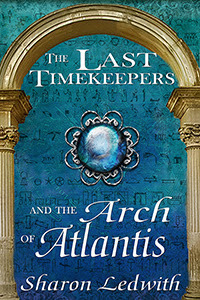 Amanda Sault silently studied the words she just scrawled: May 1st, 1214—Games and songs and revelry, act as the cloak of devilry. So that an English legend may give to the poor, we must travel to Nottingham to even the score.
Amanda Sault silently studied the words she just scrawled: May 1st, 1214—Games and songs and revelry, act as the cloak of devilry. So that an English legend may give to the poor, we must travel to Nottingham to even the score.
She frowned. She was the Scribe. Amanda knew that meant she was supposed to understand what this riddle meant. But she didn’t have a clue. All she knew was that she, her four annoying classmates, and two offbeat adults were standing in what was left of the lost continent of Atlantis and they were supposed to be the Timekeepers, the legendary time travelers handpicked by destiny to keep Earth’s history safe from evil. But no one had told them how they were supposed to do it.
Their problem: no matter what happened—good or bad—they weren’t supposed to mess with the past. Period. Dot. End of story. Amanda felt hot liquid build in her throat. Her thumb traced the words of the arcane riddle. Their first Timekeeper mission. Amanda knew this wasn’t the end of the story.
This was just the beginning.
To read more of The Last Timekeepers and the Arch of Atlantis or purchase a copy, please click a vendor's name
Mirror World Publishing - Amazon US - Amazon CA
 Sharon Ledwith is the author of the middle-grade/YA time travel series, THE LAST TIMEKEEPERS, available through Mirror World Publishing, and is represented by Walden House (Books & Stuff) for her teen psychic series, MYSTERIOUS TALES FROM FAIRY FALLS. When not writing, researching, or revising, she enjoys reading, exercising, anything arcane, and an occasional dram of scotch. Sharon lives a serene, yet busy life in a southern tourist region of Ontario, Canada, with her hubby, one spoiled yellow Labrador and a moody calico cat.
Sharon Ledwith is the author of the middle-grade/YA time travel series, THE LAST TIMEKEEPERS, available through Mirror World Publishing, and is represented by Walden House (Books & Stuff) for her teen psychic series, MYSTERIOUS TALES FROM FAIRY FALLS. When not writing, researching, or revising, she enjoys reading, exercising, anything arcane, and an occasional dram of scotch. Sharon lives a serene, yet busy life in a southern tourist region of Ontario, Canada, with her hubby, one spoiled yellow Labrador and a moody calico cat.
Learn more about Sharon Ledwith on her website and blog . Stay connected on Facebook and Twitter , Google+ , and Goodreads . Look up her Amazon Author page for a list of current books.
Check out THE LAST TIMEKEEPERS TIME TRAVEL SERIES Facebook page .
Legends. We love them. We can’t get enough of them. In fact we NEED them. Legends connect humanity in ways we can’t fathom. A legend, by definition is a story handed down for generations among a people and popularly believed to have a historical basis, although not verifiable. In book one of my time travel series, The Last Timekeepers and the Arch of Atlantis, Amanda Sault, her four classmates, and two tag-along adults are whisked through an arch they find buried in an overgrown garden, and transported to the mythical continent of Atlantis. They’ve been summoned to become Timekeepers—legendary time travelers sworn to keep history safe from an evil force known only as Belial. Oh, BTW—they’re not just any Timekeepers—they’re the Last Timekeepers. No pressure, right? Well, maybe a smidgen.
The Timekeepers first mission involves going back to 1214 England, actually Nottingham to be precise. There, Amanda and her time traveling cohorts meet an adolescent Robin Hood, although he is known as Robyn Hodekin to the people of Nottingham. So here’s the rub—in The Last Timekeepers and the Arch of Atlantis, what’s myth and what’s made-up? That’s when it’s up to the reader to seek the truth and dispel the lies.
Here’s a little help:

Robin Hood—if he did exist—was known by many names. Robyn Hode, Robert Earl of Huntingdon, Robert Fitz Ooth, and Robert fitz Odo to name a few. The first written references to our hero are brief. The earliest comes in the poem Piers Plowman, written in 1377 by the London cleric William Langland. One of his characters, an idle priest, says in passing, “I know the rhymes of Robin Hood,” but that is all. The oldest surviving substantial account of Robin Hood in his wider setting was printed in 1510, and is called A Geste of Robin Hood, the word Geste probably meaning a tale of heroic exploits. BTW—“Robin Hood in Sherwood stood” was one verse found preserved in a scrap of manuscript from Lincoln Cathedral, and was dated around 1410.
Mortimer’s Hole—The Mortimer and his hole in my story is fictional. The real Mortimer’s Hole is a 98 metre long man-made tunnel that takes you from the foot of castle rock up to the Upper Bailey in the castle grounds. It is named after Roger Mortimer. On the night of 19th October 1330 one of the most dramatic events in the history of the castle took place when the supporters of 15 year old King Edward III entered the castle through a secret passage —now named Mortimer's Hole. They captured Queen Isabella and her lover, Roger Mortimer, who had usurped the young King and were ruling England in his place. Mortimer was taken to London where he was executed. Mortimer's Hole was probably used as a food chute in medieval times.
 Nottingham caves—Totally factual! Beneath the houses, shops and offices of Nottingham lie hundreds of caves. Few people in Nottingham are aware of this labyrinth, which exists underneath the city streets, and fewer still have visited them. Nottingham has more man-made caves than anywhere else in Britain. People have worked and lived in them for over 1,000 years. None of these caves were formed naturally. They were all cut into the sandstone by the city’s inhabitants for use as houses, cellars and place of work. Each cave in unique and created for a specific purpose, some have elaborate carvings, pillars and staircases. Take a virtual tour if you dare: http://nottinghamcavessurvey.org.uk/
Nottingham caves—Totally factual! Beneath the houses, shops and offices of Nottingham lie hundreds of caves. Few people in Nottingham are aware of this labyrinth, which exists underneath the city streets, and fewer still have visited them. Nottingham has more man-made caves than anywhere else in Britain. People have worked and lived in them for over 1,000 years. None of these caves were formed naturally. They were all cut into the sandstone by the city’s inhabitants for use as houses, cellars and place of work. Each cave in unique and created for a specific purpose, some have elaborate carvings, pillars and staircases. Take a virtual tour if you dare: http://nottinghamcavessurvey.org.uk/
Knights Templar— The Knights Templar trace their origin back to shortly after the First Crusade. Around 1119, a French nobleman, Hughes de Payens, collected eight of his knight relatives, and began the Order, their stated mission to protect pilgrims on their journey to visit the Holy Places. Knights of the Order wore white mantles, assigned to the Templars in 1129 at the Council of Troyes and surcoats quartered by a red cross, a symbol of martyrdom, probably added at the start of the Second Crusade in 1147, and were heavily armored knights from the aristocracy with war horses. Knights had to wear their white mantles as all times, even when eating and drinking.
The Rockyard Inn—The name is fictional. Much of the history of the Inn is very poorly recorded. An archaeological dig in 1974 proved conclusively that the location of the original Brewhouse could only be that of the caves of Ye Olde Trip To Jerusalem, the Inn that exists there presently. This established that the Castle Brewhouse existed prior to 1189AD but the first dated reference is to be found is in the records of the City Council for the year 1618. The parochial rights to the area now known as the Brewhouse Yard did not in fact belong to the Castle but passed backwards and forward over time between the Priory of Lenton, The Knights Templar and the Knights of Saint John of Jerusalem.
Here’s an excerpt from The Last Timekeepers and the Arch of Atlantis:
 Amanda Sault silently studied the words she just scrawled: May 1st, 1214—Games and songs and revelry, act as the cloak of devilry. So that an English legend may give to the poor, we must travel to Nottingham to even the score.
Amanda Sault silently studied the words she just scrawled: May 1st, 1214—Games and songs and revelry, act as the cloak of devilry. So that an English legend may give to the poor, we must travel to Nottingham to even the score.She frowned. She was the Scribe. Amanda knew that meant she was supposed to understand what this riddle meant. But she didn’t have a clue. All she knew was that she, her four annoying classmates, and two offbeat adults were standing in what was left of the lost continent of Atlantis and they were supposed to be the Timekeepers, the legendary time travelers handpicked by destiny to keep Earth’s history safe from evil. But no one had told them how they were supposed to do it.
Their problem: no matter what happened—good or bad—they weren’t supposed to mess with the past. Period. Dot. End of story. Amanda felt hot liquid build in her throat. Her thumb traced the words of the arcane riddle. Their first Timekeeper mission. Amanda knew this wasn’t the end of the story.
This was just the beginning.
To read more of The Last Timekeepers and the Arch of Atlantis or purchase a copy, please click a vendor's name
Mirror World Publishing - Amazon US - Amazon CA
 Sharon Ledwith is the author of the middle-grade/YA time travel series, THE LAST TIMEKEEPERS, available through Mirror World Publishing, and is represented by Walden House (Books & Stuff) for her teen psychic series, MYSTERIOUS TALES FROM FAIRY FALLS. When not writing, researching, or revising, she enjoys reading, exercising, anything arcane, and an occasional dram of scotch. Sharon lives a serene, yet busy life in a southern tourist region of Ontario, Canada, with her hubby, one spoiled yellow Labrador and a moody calico cat.
Sharon Ledwith is the author of the middle-grade/YA time travel series, THE LAST TIMEKEEPERS, available through Mirror World Publishing, and is represented by Walden House (Books & Stuff) for her teen psychic series, MYSTERIOUS TALES FROM FAIRY FALLS. When not writing, researching, or revising, she enjoys reading, exercising, anything arcane, and an occasional dram of scotch. Sharon lives a serene, yet busy life in a southern tourist region of Ontario, Canada, with her hubby, one spoiled yellow Labrador and a moody calico cat.Learn more about Sharon Ledwith on her website and blog . Stay connected on Facebook and Twitter , Google+ , and Goodreads . Look up her Amazon Author page for a list of current books.
Check out THE LAST TIMEKEEPERS TIME TRAVEL SERIES Facebook page .
Published on April 17, 2016 22:30
April 12, 2016
FAST AND FURIOUS MEAL PREP
by Janis Lane
How do you plan your shopping? Sit down and figure out a week of meals? Grab what’s on sale at the grocery store? Buy a week’s meat and plan the rest around that? At my house we build in left-over meals and give them equal importance to the food at first appearance. After a delicious pot roast, potatoes, carrots, next day is planned a favorite, Pot Roast Soup.
Easy peasy to make when you have the broth, meat and three of the veggies already there.
TONIGHT’S MENU
 Leftover Pot Roast Soup
Leftover Pot Roast Soup
Salad
Corn Bread or Sesame Seed rolls
Leftover Pot Roast Soup
1 – 2 cups cubed pot roast
½ cup cooked or 1 cup fresh cubed potato
½ cup cooked or 1 cup fresh onion, sliced
1 cup carrots, cooked and diced
8 oz can tomatoes diced.
1 cup total fresh or frozen green beans, peas, broccoli bits, corn*
Broth from the previously cooked pot roast plus 1 cube beef bullion
1 cup water, more if you like extra broth.
1 sprig fresh thyme or pinch dried, remove sprig before serving
½ tsp. chopped fresh basil or dash dried, optional
Combine all ingredients in a medium-sized pot. Bring to a boil and simmer on low heat 35 to 45 minutes. Ideally everything in your soup is cooked or fresh, but the flavors need to blend. Stir occasionally.
Do not add water at the last minute. Make that decision at the beginning of your prep.
*Careful not to add too much. Remember - this is a soup, not a stew.
While you wait, use your favorite corn bread recipe and prepare a simple salad.
Quick Salad
Lettuce, Romaine, Buttercrunch, or one of the dark salad greens. Iceberg is okay
Canned peaches or slices of fresh apple/pears/oranges/ avocado/ fresh or canned pineapple
Dollop cream cheese or a small slice cheddar
Sprinkle of nutmeg
Arrange lettuce on a salad plate. Top with fruit. Add the cheese and nutmeg. Refrigerate until ready to serve.
Dessert
Cookie and one cup of your favorite ice cream
Any pot roast left over? Freeze and serve at a later time over baked potato.
Please allow me to introduce you to my latest cozy mystery, a Detective Kevin Fowler short story, for your reading pleasure.
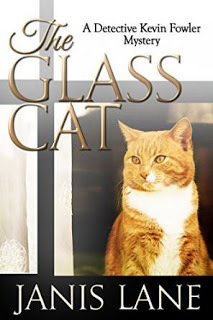 Can reality be bridged by the distress of an elderly woman?
Can reality be bridged by the distress of an elderly woman?
A handsome new neighbor sneezes when he enters the home of an elderly woman who owns only glass cats.
Is there a romance beginning between both her neighbors?
The death of a greedy, abusive nephew is rendered poetic justice.
Detective Kevin Fowler investigates.
Read more about the cozy mysteries by Janis Lane on Amazon .

Janis Lane is the pen-name for gifted author Emma Lane who writes cozy mysteries as Janis, Regency as Emma, and spicy as Sunny Lanee.
She lives in Western New York where winter is snowy, spring arrives with rave reviews, summer days are long and velvet, and fall leaves are riotous in color. At long last she enjoys the perfect bow window for her desk where she is treated to a year-round panoramic view of nature. Her computer opens up a fourth fascinating window to the world. Her patient husband is always available to help with a plot twist and encourage Emma to never quit. Her day job is working with flowers at Herbtique and Plant Nursery, the nursery she and her son own.
Look for information about writing and plants on Emma's new website . Leave a comment or a gardening question and put a smile on Emma's face.
Stay connected to Emma on Facebook and Twitter .
How do you plan your shopping? Sit down and figure out a week of meals? Grab what’s on sale at the grocery store? Buy a week’s meat and plan the rest around that? At my house we build in left-over meals and give them equal importance to the food at first appearance. After a delicious pot roast, potatoes, carrots, next day is planned a favorite, Pot Roast Soup.
Easy peasy to make when you have the broth, meat and three of the veggies already there.
TONIGHT’S MENU
 Leftover Pot Roast Soup
Leftover Pot Roast SoupSalad
Corn Bread or Sesame Seed rolls
Leftover Pot Roast Soup
1 – 2 cups cubed pot roast
½ cup cooked or 1 cup fresh cubed potato
½ cup cooked or 1 cup fresh onion, sliced
1 cup carrots, cooked and diced
8 oz can tomatoes diced.
1 cup total fresh or frozen green beans, peas, broccoli bits, corn*
Broth from the previously cooked pot roast plus 1 cube beef bullion
1 cup water, more if you like extra broth.
1 sprig fresh thyme or pinch dried, remove sprig before serving
½ tsp. chopped fresh basil or dash dried, optional
Combine all ingredients in a medium-sized pot. Bring to a boil and simmer on low heat 35 to 45 minutes. Ideally everything in your soup is cooked or fresh, but the flavors need to blend. Stir occasionally.
Do not add water at the last minute. Make that decision at the beginning of your prep.
*Careful not to add too much. Remember - this is a soup, not a stew.
While you wait, use your favorite corn bread recipe and prepare a simple salad.
Quick Salad
Lettuce, Romaine, Buttercrunch, or one of the dark salad greens. Iceberg is okay
Canned peaches or slices of fresh apple/pears/oranges/ avocado/ fresh or canned pineapple
Dollop cream cheese or a small slice cheddar
Sprinkle of nutmeg
Arrange lettuce on a salad plate. Top with fruit. Add the cheese and nutmeg. Refrigerate until ready to serve.
Dessert
Cookie and one cup of your favorite ice cream
Any pot roast left over? Freeze and serve at a later time over baked potato.
Please allow me to introduce you to my latest cozy mystery, a Detective Kevin Fowler short story, for your reading pleasure.
 Can reality be bridged by the distress of an elderly woman?
Can reality be bridged by the distress of an elderly woman?A handsome new neighbor sneezes when he enters the home of an elderly woman who owns only glass cats.
Is there a romance beginning between both her neighbors?
The death of a greedy, abusive nephew is rendered poetic justice.
Detective Kevin Fowler investigates.
Read more about the cozy mysteries by Janis Lane on Amazon .

Janis Lane is the pen-name for gifted author Emma Lane who writes cozy mysteries as Janis, Regency as Emma, and spicy as Sunny Lanee.
She lives in Western New York where winter is snowy, spring arrives with rave reviews, summer days are long and velvet, and fall leaves are riotous in color. At long last she enjoys the perfect bow window for her desk where she is treated to a year-round panoramic view of nature. Her computer opens up a fourth fascinating window to the world. Her patient husband is always available to help with a plot twist and encourage Emma to never quit. Her day job is working with flowers at Herbtique and Plant Nursery, the nursery she and her son own.
Look for information about writing and plants on Emma's new website . Leave a comment or a gardening question and put a smile on Emma's face.
Stay connected to Emma on Facebook and Twitter .
Published on April 12, 2016 22:30
April 10, 2016
PROFESSIONAL MISCONCEPTIONS
Emilia Mancini is more than just hot sex. She's an author with strong opinions on journalism and she's here today to share them. The floor is all your, Em!
My editor side has seen an influx of book submissions with journalists as main characters lately. This is great for me. I love reading about journalists!
 Photo by Graur CodrinI’m a freelance writer for a local magazine in the daylight hours. Yes, I cover features instead of hard news, but I had to go to journalism school for this, and I certainly have to live the journalist life: deadlines that bitch slap the crap out of me, editors who aren’t happy with my story, sitting outside (not exactly stalking) the house of a source who won’t return my calls so I can catch them face-to-face…
Photo by Graur CodrinI’m a freelance writer for a local magazine in the daylight hours. Yes, I cover features instead of hard news, but I had to go to journalism school for this, and I certainly have to live the journalist life: deadlines that bitch slap the crap out of me, editors who aren’t happy with my story, sitting outside (not exactly stalking) the house of a source who won’t return my calls so I can catch them face-to-face…
So, yeah, I really love reading stories about journalists. I even wrote one as Marci Boudreaux.
But I get a little worked up when I read misrepresentations of reporters. Just this week, I vented to the LLL ladies about this very topic (which lead to this lovely post). Now I know you are writing fiction and things get twisted and turned and exaggerated, but if you are writing contemporary, you have to be somewhat realistic and I’ve found that frequently isn’t happening when journalists are being written into fiction.
I just want to take a moment to clear the air a little so if you are considering using a print journalist as a character in your book (for good or for evil) some of these stereotypical, panty-bunching mistakes aren’t made in your manuscript.
1 - Easily my biggest issue with people writing newspaper articles is using the phrase “this reporter.” As in, “This reporter was told the world is round.” This phrase may have been used 100 years ago, but it isn’t used now. It insinuates the writer into the article, which is completely unprofessional and no newspaper editor would let this in. Ever. Reporters are telling the facts, without opinion, personal interpretation, or commentary…unless they are an opinion columnist.
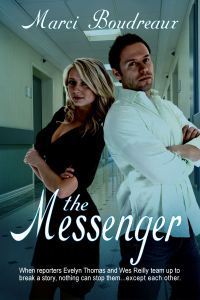 2 - Reporters don’t have money to throw around. Newspaper reporters make less than 30K per year, maybe 35K if they work for a decent-sized paper, but overall, we are a very poor lot. In
The Messenger
, my main character came from money. She had a nice apartment, clothes, and car because she used her trust fund to get these things. She was the misfit in the news office based on the those with vs. those without mentality of her co-workers. Overall, unless you set it up otherwise, your reporter should drive an average car, shop at average stores, and live in average homes. Sure, there are exceptions, but your everyday newspaper reporter does not drive a Lexus.
2 - Reporters don’t have money to throw around. Newspaper reporters make less than 30K per year, maybe 35K if they work for a decent-sized paper, but overall, we are a very poor lot. In
The Messenger
, my main character came from money. She had a nice apartment, clothes, and car because she used her trust fund to get these things. She was the misfit in the news office based on the those with vs. those without mentality of her co-workers. Overall, unless you set it up otherwise, your reporter should drive an average car, shop at average stores, and live in average homes. Sure, there are exceptions, but your everyday newspaper reporter does not drive a Lexus.
3 - Sensational commentary in a news article would never happen. Reporters write facts. They have sources (quotes from experts, witnesses, or validated research) to back up these facts. This is a requirement for making it to print because people like to sue newspapers. Editors will not approve/print scandalous content. Serious reporters aren’t going to insert opinion, personal jabs, or any other commentary.
4 - Newspapers as a whole are broke. This means reporters take their own pictures with the shared office camera and drive their own cars to get the story. Newspapers do not provide photographers to go on assignment with reporters and they don’t provide transportation (though if a reporter is full-time, gas mileage may be reimbursed).
5 - The last time I, or one of my co-workers, wore a suit to an interview was…oh, right, never. Print journalists don’t dress in business suits. At least not your average reporter. Think business casual. Khakis or nice jeans and a semi-dress shirt. A skirt and blouse. One editor I know loves his corduroys, but suits are just not something I’ve seen in the newsroom—except for the publisher, but he’s in business meetings all day with other men/women in suits, so that makes sense.
6 - I know reporters are usually viewed as a force of evil. Some probably are. We share the horrors of the world more than we share the laughs. But, honestly, if the media only covered the good things, the public would criticize them for not being truthful about the events of the world. Most people view reporters as heartless demons who would step over dying babies to get the scoop. The truth is, we’re human, too. Maybe we don’t break down on the scene, but I guarantee you, even the toughest of reporters have gotten emotional over something they covered. Don’t portray your journalist as a one-dimensional heartless story-grabbing asshat. That’s a stereotype that has been overplayed.
Okay, so that kind of wraps up the biggies. The moral of this blog post? Do some research, whether it is a journalist or a doctor you are including in your manuscript. One phone call and a few questions is all you need to make sure you aren’t making crucial mistakes when representing a profession. Most people are more than happy to tell you what their job is really like. All you have to do is ask.
Here's a little teaser from my latest sexy release for your reading pleasure.
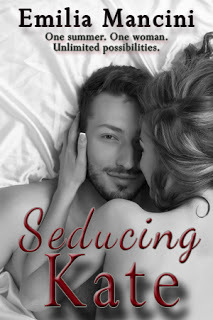 It took Kyle one look to realize he wanted to seduce his best friend’s mother. And one kiss to realize he didn't have to.
It took Kyle one look to realize he wanted to seduce his best friend’s mother. And one kiss to realize he didn't have to.
It was lust at first sight for Kyle when he met his roommate Justin’s mother Kate. Kyle, a college transfer, was too far from home to visit on short school breaks, so Justin took him to Minneapolis where his mother was serving up a family meal for Thanksgiving.
One look left Kyle with a healthy obsession for Kate which grew with each visit. When he landed an internship in Minneapolis, he moved in with Kate for the summer, and got in touch with his voyeuristic side. It wasn’t until one late evening and a few too many glasses of wine that Kyle began to suspect his attraction wasn’t one-sided.
When he dared to push the issue, he found Kate more than willing to succumb to his seduction.
BUY LINKS
Amazon - Barnes & Noble

Emilia Mancini is the naughtier side to author Marci Boudreaux. Emilia stays hidden in the shadows like a nefarious side kick, slipping out only when the stories Marci wants to share are a little too grown up to be called sweet romance.
Seducing Kate is Emilia’s second release and, at least for the moment, her crowning glory.
Be sure to check out the Pinterest board for Seducing Kate .
Visit Emilia on her website . Stay connected on Twitter and Facebook .
My editor side has seen an influx of book submissions with journalists as main characters lately. This is great for me. I love reading about journalists!
 Photo by Graur CodrinI’m a freelance writer for a local magazine in the daylight hours. Yes, I cover features instead of hard news, but I had to go to journalism school for this, and I certainly have to live the journalist life: deadlines that bitch slap the crap out of me, editors who aren’t happy with my story, sitting outside (not exactly stalking) the house of a source who won’t return my calls so I can catch them face-to-face…
Photo by Graur CodrinI’m a freelance writer for a local magazine in the daylight hours. Yes, I cover features instead of hard news, but I had to go to journalism school for this, and I certainly have to live the journalist life: deadlines that bitch slap the crap out of me, editors who aren’t happy with my story, sitting outside (not exactly stalking) the house of a source who won’t return my calls so I can catch them face-to-face…So, yeah, I really love reading stories about journalists. I even wrote one as Marci Boudreaux.
But I get a little worked up when I read misrepresentations of reporters. Just this week, I vented to the LLL ladies about this very topic (which lead to this lovely post). Now I know you are writing fiction and things get twisted and turned and exaggerated, but if you are writing contemporary, you have to be somewhat realistic and I’ve found that frequently isn’t happening when journalists are being written into fiction.
I just want to take a moment to clear the air a little so if you are considering using a print journalist as a character in your book (for good or for evil) some of these stereotypical, panty-bunching mistakes aren’t made in your manuscript.
1 - Easily my biggest issue with people writing newspaper articles is using the phrase “this reporter.” As in, “This reporter was told the world is round.” This phrase may have been used 100 years ago, but it isn’t used now. It insinuates the writer into the article, which is completely unprofessional and no newspaper editor would let this in. Ever. Reporters are telling the facts, without opinion, personal interpretation, or commentary…unless they are an opinion columnist.
 2 - Reporters don’t have money to throw around. Newspaper reporters make less than 30K per year, maybe 35K if they work for a decent-sized paper, but overall, we are a very poor lot. In
The Messenger
, my main character came from money. She had a nice apartment, clothes, and car because she used her trust fund to get these things. She was the misfit in the news office based on the those with vs. those without mentality of her co-workers. Overall, unless you set it up otherwise, your reporter should drive an average car, shop at average stores, and live in average homes. Sure, there are exceptions, but your everyday newspaper reporter does not drive a Lexus.
2 - Reporters don’t have money to throw around. Newspaper reporters make less than 30K per year, maybe 35K if they work for a decent-sized paper, but overall, we are a very poor lot. In
The Messenger
, my main character came from money. She had a nice apartment, clothes, and car because she used her trust fund to get these things. She was the misfit in the news office based on the those with vs. those without mentality of her co-workers. Overall, unless you set it up otherwise, your reporter should drive an average car, shop at average stores, and live in average homes. Sure, there are exceptions, but your everyday newspaper reporter does not drive a Lexus.3 - Sensational commentary in a news article would never happen. Reporters write facts. They have sources (quotes from experts, witnesses, or validated research) to back up these facts. This is a requirement for making it to print because people like to sue newspapers. Editors will not approve/print scandalous content. Serious reporters aren’t going to insert opinion, personal jabs, or any other commentary.
4 - Newspapers as a whole are broke. This means reporters take their own pictures with the shared office camera and drive their own cars to get the story. Newspapers do not provide photographers to go on assignment with reporters and they don’t provide transportation (though if a reporter is full-time, gas mileage may be reimbursed).
5 - The last time I, or one of my co-workers, wore a suit to an interview was…oh, right, never. Print journalists don’t dress in business suits. At least not your average reporter. Think business casual. Khakis or nice jeans and a semi-dress shirt. A skirt and blouse. One editor I know loves his corduroys, but suits are just not something I’ve seen in the newsroom—except for the publisher, but he’s in business meetings all day with other men/women in suits, so that makes sense.
6 - I know reporters are usually viewed as a force of evil. Some probably are. We share the horrors of the world more than we share the laughs. But, honestly, if the media only covered the good things, the public would criticize them for not being truthful about the events of the world. Most people view reporters as heartless demons who would step over dying babies to get the scoop. The truth is, we’re human, too. Maybe we don’t break down on the scene, but I guarantee you, even the toughest of reporters have gotten emotional over something they covered. Don’t portray your journalist as a one-dimensional heartless story-grabbing asshat. That’s a stereotype that has been overplayed.
Okay, so that kind of wraps up the biggies. The moral of this blog post? Do some research, whether it is a journalist or a doctor you are including in your manuscript. One phone call and a few questions is all you need to make sure you aren’t making crucial mistakes when representing a profession. Most people are more than happy to tell you what their job is really like. All you have to do is ask.
Here's a little teaser from my latest sexy release for your reading pleasure.
 It took Kyle one look to realize he wanted to seduce his best friend’s mother. And one kiss to realize he didn't have to.
It took Kyle one look to realize he wanted to seduce his best friend’s mother. And one kiss to realize he didn't have to.It was lust at first sight for Kyle when he met his roommate Justin’s mother Kate. Kyle, a college transfer, was too far from home to visit on short school breaks, so Justin took him to Minneapolis where his mother was serving up a family meal for Thanksgiving.
One look left Kyle with a healthy obsession for Kate which grew with each visit. When he landed an internship in Minneapolis, he moved in with Kate for the summer, and got in touch with his voyeuristic side. It wasn’t until one late evening and a few too many glasses of wine that Kyle began to suspect his attraction wasn’t one-sided.
When he dared to push the issue, he found Kate more than willing to succumb to his seduction.
BUY LINKS
Amazon - Barnes & Noble

Emilia Mancini is the naughtier side to author Marci Boudreaux. Emilia stays hidden in the shadows like a nefarious side kick, slipping out only when the stories Marci wants to share are a little too grown up to be called sweet romance.
Seducing Kate is Emilia’s second release and, at least for the moment, her crowning glory.
Be sure to check out the Pinterest board for Seducing Kate .
Visit Emilia on her website . Stay connected on Twitter and Facebook .
Published on April 10, 2016 22:30



